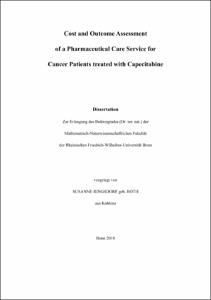Cost and Outcome Assessment of a Pharmaceutical Care Service for Cancer Patients treated with Capecitabine

Cost and Outcome Assessment of a Pharmaceutical Care Service for Cancer Patients treated with Capecitabine

| dc.contributor.advisor | Jaehde, Ulrich | |
| dc.contributor.author | Ringsdorf, Susanne | |
| dc.date.accessioned | 2020-04-15T21:07:49Z | |
| dc.date.available | 2020-04-15T21:07:49Z | |
| dc.date.issued | 08.12.2010 | |
| dc.identifier.uri | https://hdl.handle.net/20.500.11811/4696 | |
| dc.description.abstract | Objective: The present study aimed at evaluating the costs and benefits of a pharmaceutical care (PC) service delivered to cancer patients treated with capecitabine compared to standard care (SC) from a health insurance perspective. Methods: An open, prospective, multi-centred cohort study with a preceding control group was chosen as the study design. Colorectal and breast cancer patients treated with capecitabine were included in the study. For a study period of six months control patients received SC whereas intervention patients received intensified PC. Endpoints among others were direct disease-related outpatient and inpatient costs and quality adjusted life years (QALYs). Utility scores were derived from the EQ-5D questionnaire. A cost-utility analysis was conducted with data from retrospectively matched patient pairs. Matching parameters were tumor entity, therapy setting (neoadjuvant, adjuvant or palliative), therapy regimen at time of inclusion and type of health insurance. Results: Thirty patients were analysed in the control group (CG) and 46 patients in the intervention group (IG). The retrospective finding of matched-pairs yielded eleven patient pairs. Costs for antineoplastic therapy played a dominant role in both patient groups (CG: 59 %, IG: 71 % of total direct costs), followed by costs for inpatient stays (CG: 19 %, IG: 14 % of total direct costs). PC was associated with a gain in mean QALYs compared to SC (0.40, SD: 0.14 versus 0.32, SD: 0.19), at lower mean costs (€ 15606, SD: 13816 versus € 16080, SD: 11308), demonstrating dominance of the PC service. The bootstrapping showed that in 87 % of all replications the PC service was associated with a gain in QALYs. According to the cost-effectiveness acceptability curve the probability that PC was a cost-effective strategy was 43 % at a WTP for an additional QALY of € 0, reaching 62 % probability at a WTP of € 29000 per additional QALY, which is about the implicit NICE cost-effectiveness threshold ratio. Conclusion: In terms of common understanding of cost-effectiveness the PC service was a cost-effective service in the studied patient population. The very small sample size of 22 patients included in the analysis limits the validity of the observed positive result. Further studies with a higher sample size are needed to confirm these findings. | en |
| dc.language.iso | eng | |
| dc.rights | In Copyright | |
| dc.rights.uri | http://rightsstatements.org/vocab/InC/1.0/ | |
| dc.subject | economics | |
| dc.subject | cost-utility analysis | |
| dc.subject | pharmaceutical care | |
| dc.subject | cancer | |
| dc.subject | capecitabine | |
| dc.subject.ddc | 610 Medizin, Gesundheit | |
| dc.title | Cost and Outcome Assessment of a Pharmaceutical Care Service for Cancer Patients treated with Capecitabine | |
| dc.type | Dissertation oder Habilitation | |
| dc.publisher.name | Universitäts- und Landesbibliothek Bonn | |
| dc.publisher.location | Bonn | |
| dc.rights.accessRights | openAccess | |
| dc.identifier.urn | https://nbn-resolving.org/urn:nbn:de:hbz:5N-23712 | |
| dc.relation.isbn | 978-3-86853-708-6 | |
| ulbbn.pubtype | Erstveröffentlichung | |
| ulbbn.birthname | Roth | |
| ulbbnediss.affiliation.name | Rheinische Friedrich-Wilhelms-Universität Bonn | |
| ulbbnediss.affiliation.location | Bonn | |
| ulbbnediss.thesis.level | Dissertation | |
| ulbbnediss.dissID | 2371 | |
| ulbbnediss.date.accepted | 23.11.2010 | |
| ulbbnediss.fakultaet | Mathematisch-Naturwissenschaftliche Fakultät | |
| dc.contributor.coReferee | Simoens, Steven |
Files in this item
This item appears in the following Collection(s)
-
E-Dissertationen (4465)




